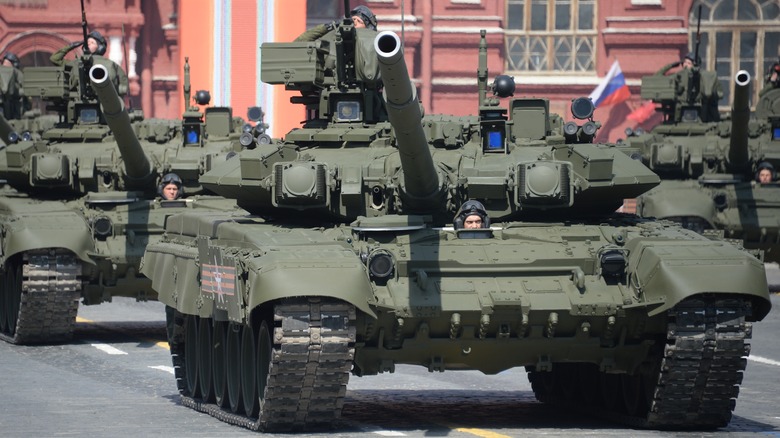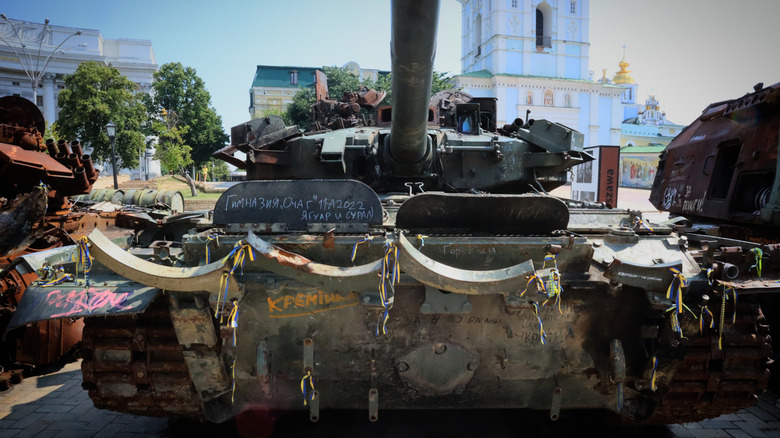Why Russia's T-90 Battle Tank Was A Total Failure In Ukraine
When Russia invaded Ukraine in February 2022, it did so with a full complement of armor brought by five armored divisions. These included tanks of all kinds, including the oft-deployed T-72 and many others. However, since entering Ukraine, few tanks remain operational — at least for the Russians. Because tanks are far from obsolete in battle, the Ukrainian military has made a habit of capturing Russian armor, refitting it for their use, and redeploying it onto the battlefield.
According to The International Institute for Strategic Studies, Russia has lost more than 8,800 armored vehicles since the start of the conflict. This staggering number is telling, as it demonstrates Russia's inability to decisively operate its armored combat vehicles. Because of this, Russia took tanks out of mothballs from storage facilities, dusted them off, and retrofitted them for battle, and it did this with tanks dating back to post-WWII.
The desperation of Russia's armored units is evident in its use of antiquated technology, leading many to wonder what happened to Russia's modern Main Battle Tanks (MBT). Russia's primary MBT is the T-14 Armata — one of the best military tanks in the world — but cost overruns, corruption in the system, and other issues haven't enabled its widespread deployment. That's where the T-90 comes into play, as it remains Russia's MBT operating in Ukraine, and it's also utterly failed to live up to expectations.
What is the T-90, and what caused its failure?
The T-90 entered active service in 1992 and has undergone multiple upgrades since, with the most recent upgrade occurring in 2017. The tank boasts many improvements over its predecessor, the T-72, which similarly failed miserably in Ukraine and is the basis upon which the T-90 was developed. The T-90 has Kontakt-5 explosive reactive armor, which is some of the best defensive armor developed for tanks in and out of Russia. Unfortunately, while this type of armor is especially useful in fighting tanks, it's almost useless against certain munitions.
Specifically, the T-90's impressive armor is almost entirely mitigated by the U.S.-made Javelin missiles supplied to Ukraine. These man-portable weapon systems are fired by small teams, and once fired, the missile shoots up and over the tank, coming down on top of it. This is where a tank has the least amount of armor and is incredibly vulnerable. When a Javelin smashes into a turret, it destroys the tank entirely or kills everyone inside while rendering it nonoperational.
Additionally, Ukraine hasn't presented the best combat operational battlespace for tanks, as many deploy to urban areas. These places aren't ideal for tank warfare, as they leave the tank open to several forms of attack, including loitering munitions, anti-tank rockets, and more. Other prominent issues that kept the T-90 from dominating the battlespace in Ukraine were poor maintenance, corruption within the Russian military, and out-of-date doctrine, all of which doomed the T-90 in Ukraine.
T-90's defenses cannot withstand numerous forms of assault
On the surface, the T-90 boasts numerous upgrades, but its operational history is suspect. Prior to Ukraine, Russia deployed the T-90 in Dagestan, Syria, and other hotspots around the world. While its combat effectiveness is difficult to determine in previous conflicts, thanks in part to the fog of war and Russia's propaganda, that cannot be said of its use in Ukraine.
By January 2024, Oryx reported that Russia lost at least 100 T-90s in Ukraine. Most were destroyed, while many were abandoned by their crews and captured by Ukrainians. That same month, a video surfaced of two U.S. M2 Bradley Fighting Vehicles taking on a T-90, and the two armored infantry fighting vehicles managed to disable the tank. The repeated fire from the M2s utterly destroyed its reactive armor, resulting in a massive explosion and disabling the tank, which the crew abandoned.
Ultimately, the Russian military's failures in Ukraine are the result of numerous factors. Among them is the deployment of armored vehicles rife with poor maintenance, poorly trained personnel, and older doctrine that belies modern tank warfare practices. The T-90 is one example of many Russian armored vehicles with a proven track record of widespread failure in combat operations. The fact that they share the battlespace with antiquated T-55s, T-62s, and T-72s, all of which belong in museums — like the far more successful T-34 — shows how unreliable Russia's modern T-90 is. Given its actions in Ukraine, that's unlikely to change.

